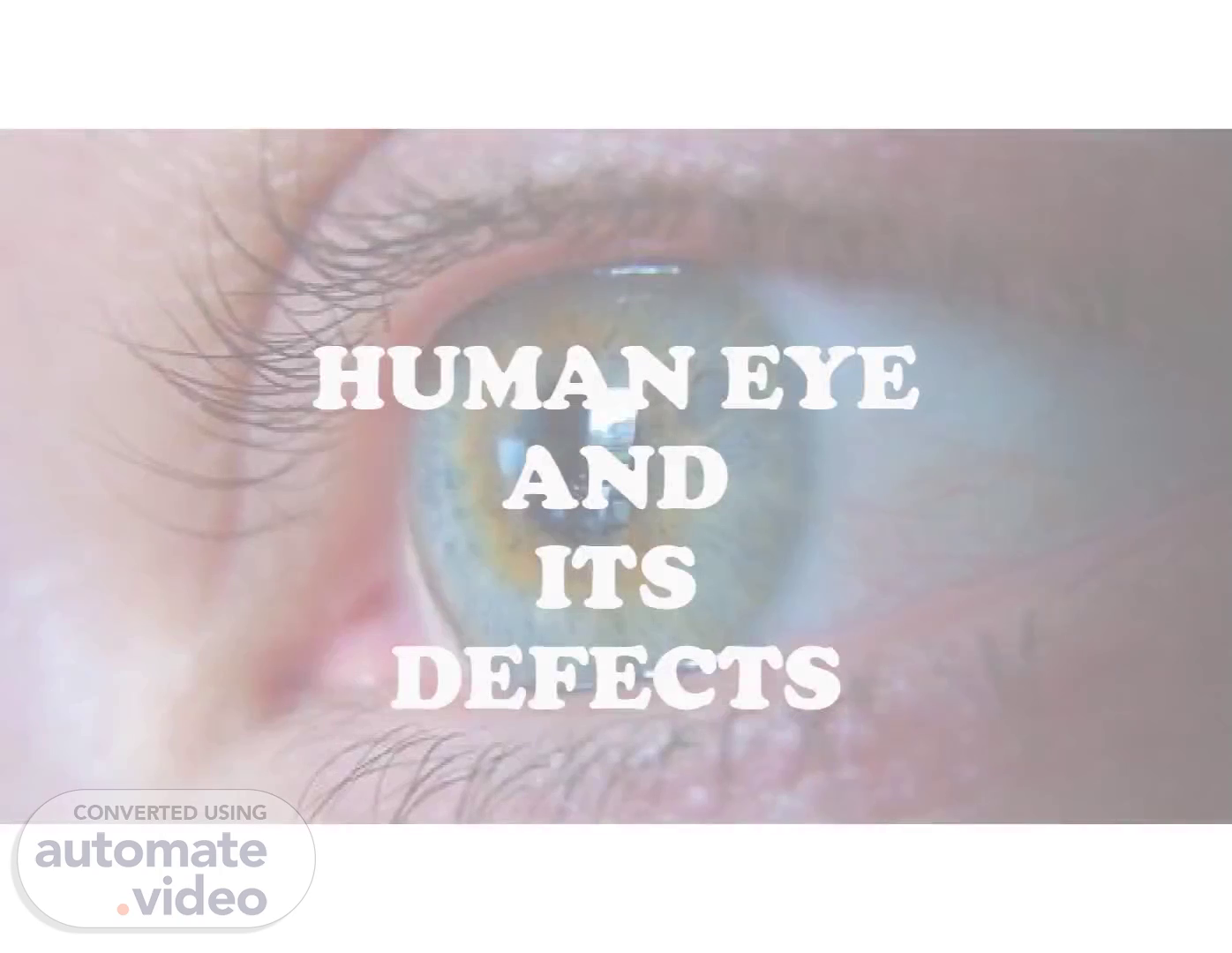
Microsoft PowerPoint - HUMAN EYE ANMOL PPT
Scene 1 (0s)
[Audio] Good morning everyone! Today we will be discussing the human eye and its defects. We will explore how the eye works and how to correct any defects of vision. It promises to be an interesting and educational exploration. Let's begin!.
Scene 2 (18s)
[Audio] The human eye is an intricate and complex organ constructed of many components that work together to give us perfect vision. The front of the eye is the cornea, a transparent and convex material that allows light to enter. Behind the cornea is the iris, the colored diaphragm with the pupil in the center, which lets light in and focuses the image on the retina. The ciliary muscles surround the eye lens, offering strength and shape to ensure the image is correctly formed on the retina. The human eye is a marvel of nature, able to detect the smallest of details with precision and accuracy..
Scene 3 (57s)
[Audio] Light rays coming from an object enter the eyes through the pupil and are focused by the eye lens to form an image on the retina. This image is then converted to electrical signals which are sent to the brain, allowing us to form a mental image. Though the image on the retina is inverted, the brain interprets it as erect..
Scene 4 (1m 17s)
[Audio] Our human eye is an important asset that helps us to chart our course in life, however it is not without its faults. Myopia, or near-sightedness, is a common vision imperfection which causes objects close to the person to appear blurry, while distant objects appear sharp. On the other hand, hypermetropia, or far-sightedness, is when distant objects appear blurry while those close to the eye are in focus. Additionally, presbyopia is an age-related vision defect in which objects close to the eye are difficult to focus on. Fortunately, thanks to modern optometry technology, lenses, and glasses, all of these vision defects can be corrected..
Scene 5 (2m 0s)
[Audio] The complexity of the human eye is impressive, allowing us to see incredible detail. Sadly, defects such as myopia can distort this, making distant objects difficult to view clearly. The cause of this is usually either an eye-ball that is too long or too much converging power of the lens. Thankfully, corrective lenses and surgery can usually be used to fix this issue, restoring the eye's remarkable abilities..
Scene 6 (2m 29s)
[Audio] Myopia, or short-sightedness, is a common eye defect which affects the ability of an individual to form a clear image on the retina. To correct this defect, a concave lens is sometimes used in spectacles. This lens reduces the converging power of the eye-lens, diverging the parallel rays of light from a distant object before they can be focused. As such, a clear image is formed on the retina. This process is necessary to correct the myopia of an individual..
Scene 7 (3m 1s)
[Audio] The human eye is an amazing part of the body, enabling vision. Hypermetropia, or long-sightedness, is an eye defect in which close up objects are hard to see clearly. This is caused by either a weak eye lens, an eye that's too short, or the image of an object being formed behind the retina. Fortunately, modern technology can help many people to overcome this condition..
Scene 8 (3m 27s)
[Audio] Hypermetropia, commonly referred to as far-sightedness, is a condition where the eyeball size is too short or the corneal curvature is too flat. A convex lens must be positioned in front of the eye to rectify the situation. This lens can direct the light rays from a nearby object onto the near point of the eye, enabling the eye-lens to focus and project an image on the retina. Consequently, a convex lens can effectively remedy hypermetropia..
Scene 9 (3m 58s)
[Audio] Our eyes are an amazing part of our bodies. They give us the ability to experience the world around us in ways that would otherwise be impossible. Unfortunately, defects in vision can sometimes reduce our ability to see clearly. Presbyopia is one such defect. It typically happens as people get older, since the ciliary muscles responsible for adjusting the eye lens become weak and inflexible. This results in nearby objects being out of focus. In the case of elderly persons, their near-point can be much farther than 25 cm. Fortunately, the defect can be corrected with a convex lens..
Scene 10 (4m 42s)
[Audio] Humans have an incredible eye that allows us to observe the world we live in. Sadly, the eye can suffer from several problems which can affect our vision. Cataracts are a widespread age-related eye issue that causes the lens of the eye to become blurred. This problem can't be corrected with glasses or contacts, but it can be treated with surgery. The procedure replaces the clouded lens with a new artificial one, restoring a person's vision and the ability to see the world clearly again..
Scene 11 (5m 15s)
[Audio] The human eye is an impressive organ, with a complex set of both difficulties and strengths. While some of these issues can be remedied with special eyewear, many cannot, so it is essential to recognize any indications you may experience and look for medical advice. Thank you for your attention and I wish you all a safe and prosperous future..